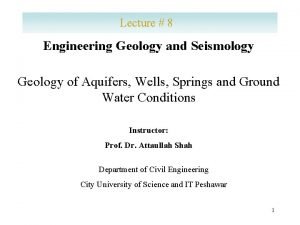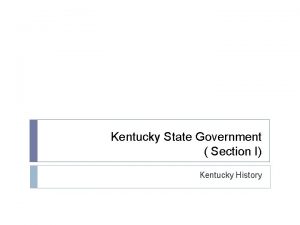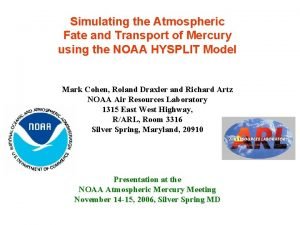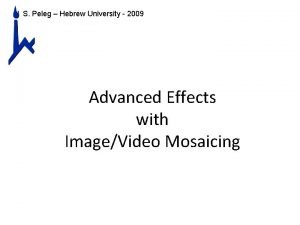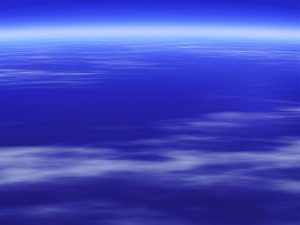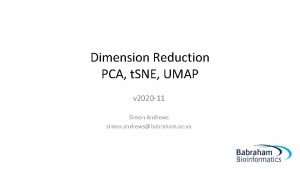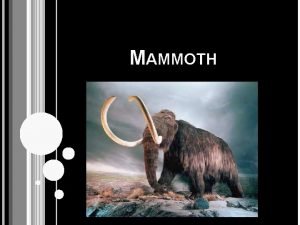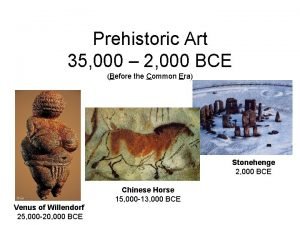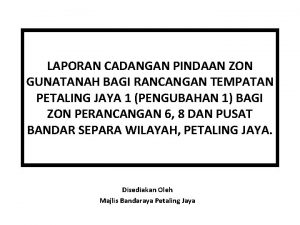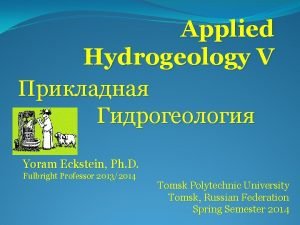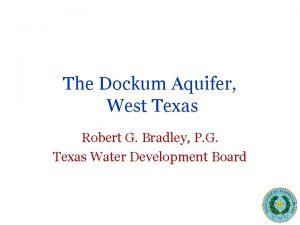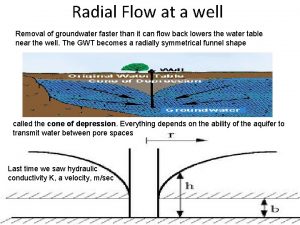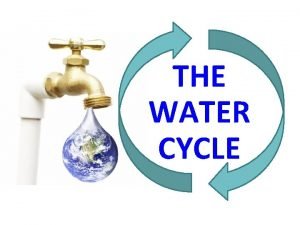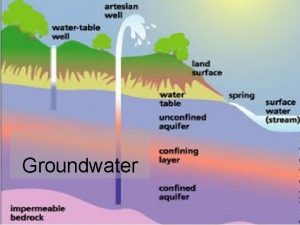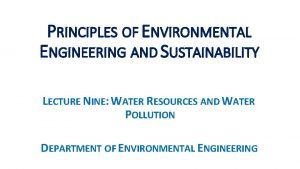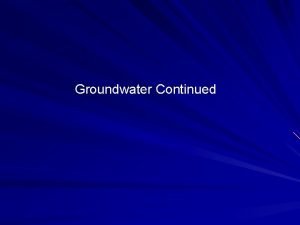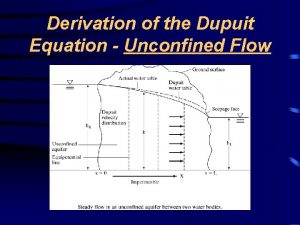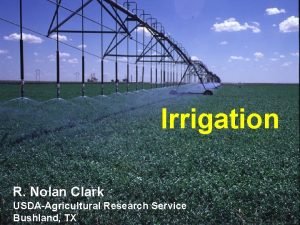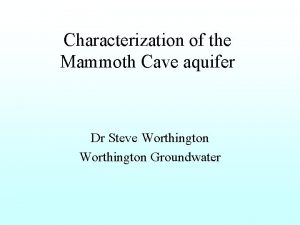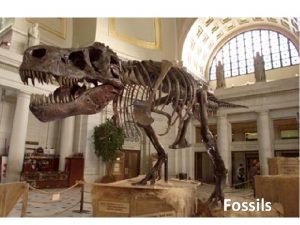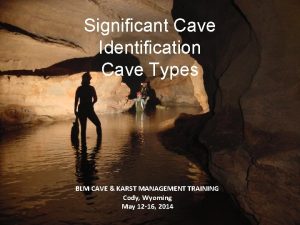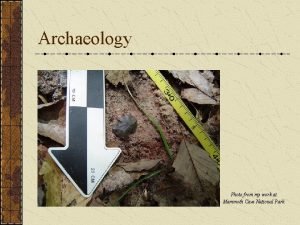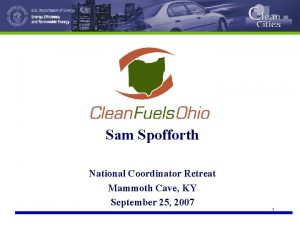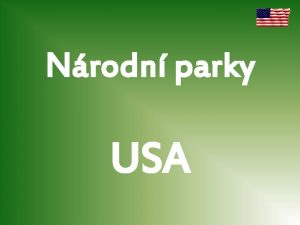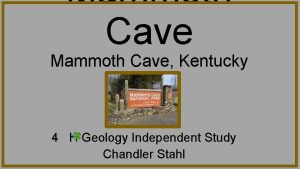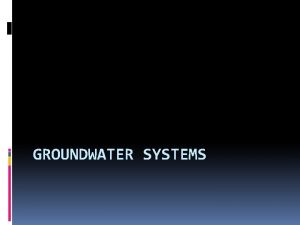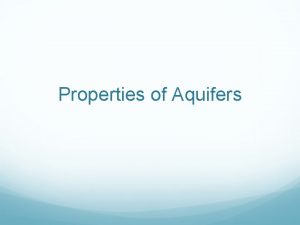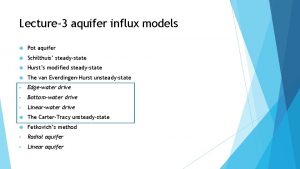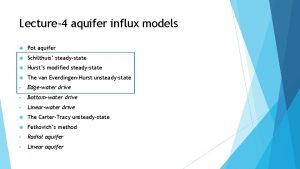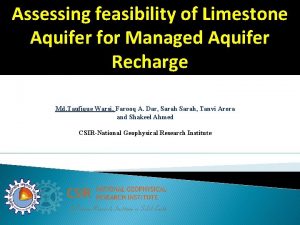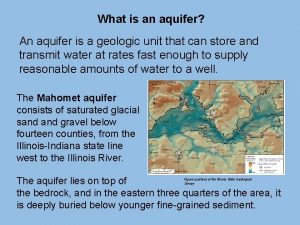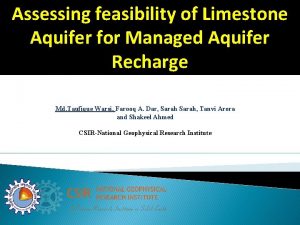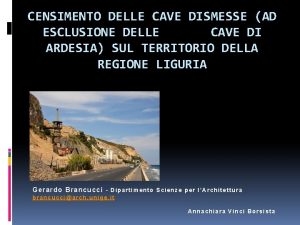Characterization of the Mammoth Cave aquifer Dr Steve




























- Slides: 28

Characterization of the Mammoth Cave aquifer Dr Steve Worthington Groundwater

Mammoth Cave area Mammoth Cave 300 miles Martin Ridge Cave

Model 1 assumptions • Karst feature are local scale • Aquifer behaves as porous medium at large scale • Useful data for calibration – 1) Heads in wells – 2) Hydraulic conductivity from well tests

Water level data

Hydraulic conductivity data • • Matrix Slug tests (geo. mean) Slug test (arith. mean) Pumping tests • MODFLOW (EPM) 2 x 10 -11 m/s 6 x 10 -6 m/s 3 x 10 -5 m/s 3 x 10 -4 m/s 1 x 10 -3 m/s

MODFLOW homogeneous EPM simulation K=1. 1 x 10 -3 m/s 48 wells mean absolute error = 12 m

Simulated tracer paths 54 tracer injection locations

Actual tracer paths from 54 inputs to 3 springs

Problems with model 1 • Major assumption incorrect • Lab studies and numerical models (e. g. Plummer and Wigley, 1976; Dreybrodt, 1996) suggest channel networks and caves should always form) • Karst aquifers are not just “features”

Model 2 assumptions • Aquifer has integrated conduit network • Useful data for calibration – 1) Heads in wells – 2) Hydraulic conductivity from well tests – 3) Heads and discharge in conduits – 4) Tracer tests

Water level data

Simulated tracer paths all 54 tracer paths go to correct spring

MODFLOW with high K cells K 2 x 10 -5 to 7 m/s Mean absolute error 4 m


Results of MODFLOW with “conduits cells” • Head error reduced from 11 m to 4 m • Tracer paths accurately shown • Model reasonable for steady-state • Poor performance for transient (hours) • Poor performance for transport • No good codes available for karst aquifers

What generalizations can be made?

Ideal sand aquifer



Ideal carbonate aquifer

Differences between karst aquifers and porous media • • • Tributary flow to springs Flow in channels with high Re Troughs in the potentiometric surface Downgradient decrease in i Downgradient increase in K Substantial scaling effects

Triple porosity at Mammoth Cave • Matrix K 10 -11 m/s • Fracture K 10 -5 m/s • Channel K 10 -3 m/s • Matrix porosity • Fracture porosity • Channel porosity - most of flow 2. 4% - most of storage 0. 03% 0. 06%

Characterizing carbonates • Wells are great for matrix and fracture studies • but only ~2 % of wells at Mammoth Cave will hit major conduits • Cave and spring studies, and sink to spring tracer tests are great for channel studies • but little is learned about matrix and fracture properties

Comparison of Mammoth Cave and N. Florida aquifers • Mammoth Cave area EPM 1. 1 x 10 -3 m/s • Mammoth Cave area with conduits 4 x 10 -5 to 7 x 100 m/s • Wakulla County 8 x 10 -6 to 2 x 10 -2 m/s (Davis, USGS WRIR 95 -4296)

Available global cave data • About 100, 000 km of caves passages at or above the water table have been mapped. • About 1000 km of cave passages below the water table have been mapped.

Increase in mapped caves • Total of mapped caves above the water table is increasing by about 8% each year. • Total of mapped caves below the water table is increasing by about 15% each year. • Only a very small fraction of all caves are known.

Significance of caves • Known caves represent examples from a large and mostly unknown data set • Most active conduits below water table • Fossil passages analog for active conduits • Fossil conduits 10 m high and wide and kilometers in length at Mammoth Cave • Hydraulic parameters and tributary network in fossil and active systems

Problems with applying cave data • Most cave data local scale, not aquifer scale • Caves above the water table may not be representative of active conduits below the water table • Water supply is usually from wells - what is relevance of cave studies?
 Confined and unconfined aquifer
Confined and unconfined aquifer Mammoth cave to louisville
Mammoth cave to louisville Mammoth cave
Mammoth cave Steve jobs steve wozniak ronald wayne
Steve jobs steve wozniak ronald wayne Kroger foods stock 1920
Kroger foods stock 1920 Mammoth camera
Mammoth camera Kamera mammoth
Kamera mammoth Mammoth vs saber tooth tiger
Mammoth vs saber tooth tiger Copyright
Copyright Mammoth tech jobs
Mammoth tech jobs Reconstruction drawing of mammoth-bone houses
Reconstruction drawing of mammoth-bone houses Kroger foods stock 1920
Kroger foods stock 1920 Tsne umap pca
Tsne umap pca Mammoth habitat description
Mammoth habitat description What era
What era Mammuthus africanavus
Mammuthus africanavus Rancangan tempatan petaling jaya
Rancangan tempatan petaling jaya What is indirect and direct characterization
What is indirect and direct characterization What is direct characterization?
What is direct characterization? Ogallala aquifer
Ogallala aquifer Aquifer lsuhsc
Aquifer lsuhsc Dockum aquifer
Dockum aquifer Aquifer well
Aquifer well Aquifers
Aquifers Gulf coast aquifer
Gulf coast aquifer Ogallala aquifer
Ogallala aquifer Aquifer
Aquifer Dupuit equation fluid mechanics
Dupuit equation fluid mechanics Ogallala aquifer
Ogallala aquifer
